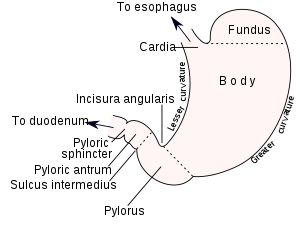Curvatures of the stomach
The curvatures of the stomach refer to the greater and lesser curvatures. The greater curvature of the stomach is four or five times as long as the lesser curvature.
| Curvatures of the stomach | |
|---|---|
 Outline of stomach, showing its anatomical landmarks. | |
| Details | |
| Artery | Greater: short gastric (upper part), left gastroepiploic (middle) Lesser: Right gastric artery and left gastric artery |
| Vein | Lesser: Right gastric vein and left gastric vein |
| Identifiers | |
| Latin | curvatura major gastris, curvatura minor gastris |
| TA | A05.5.01.004 |
| FMA | 14574 |
| Anatomical terminology | |
Greater curvature
Surface
Starting from the cardiac orifice at the incisura cardiaca, it forms an arch backward, upward, and to the left; the highest point of the convexity is on a level with the sixth left costal cartilage.
From this level it may be followed downward and forward, with a slight convexity to the left as low as the cartilage of the ninth rib; it then turns to the right, to the end of the pylorus.
Directly opposite the incisura angularis of the lesser curvature the greater curvature presents a dilatation, which is the left extremity of the pyloric part; this dilatation is limited on the right by a slight groove, the sulcus intermedius, which is about 2.5 cm, from the duodenopyloric constriction.
The portion between the sulcus intermedius and the duodenopyloric constriction is termed the pyloric antrum.
At its commencement the greater curvature is covered by peritoneum continuous with that covering the front of the organ.
The left part of the curvature gives attachment to the gastrolienal ligament, while to its anterior portion are attached the two layers of the greater omentum, separated from each other by the gastroepiploic vessels.
Blood supply
There are three arteries which primarily supply the greater curvature:
- short gastric arteries — upper part
and the gastroepiploic vessels:
- gastric branches of left gastro-omental artery — middle part
- gastric branches of right gastro-omental artery — lower part
Lesser curvature
The lesser curvature of the stomach, extending between the cardiac and pyloric orifices, forms the right or medial border of the stomach.
Structure
It descends as a continuation of the right margin of the esophagus in front of the fibers of the right crus of the diaphragm, and then, turning to the right, it crosses the first lumbar vertebra and ends at the pylorus.
Nearer its pyloric than its cardiac end is a well-marked notch, the incisura angularis, which varies somewhat in position with the state of distension of the viscus; it serves to separate the stomach into a right and a left portion.
The lesser curvature gives attachment to the two layers of the hepatogastric ligament, and between these two layers are the left gastric artery and the right gastric branch of the hepatic artery.
Additional images
- Lesser curvature
- Greater curvature
- Stomach. Lesser curvature.Deep dissection.
- Stomach. Greater curvature.Deep dissection.
See also
External links
- stomach at The Anatomy Lesson by Wesley Norman (Georgetown University)
- celiactrunk at The Anatomy Lesson by Wesley Norman (Georgetown University)
- "Anatomy diagram: 23314.000-1". Roche Lexicon - illustrated navigator. Elsevier. Archived from the original on 2012-12-05.
References
This article incorporates text in the public domain from page 1162 of the 20th edition of Gray's Anatomy (1918)